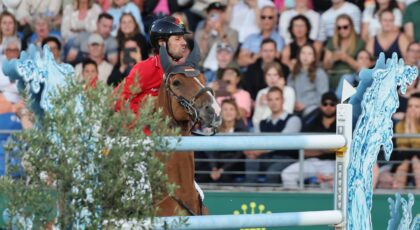There are many in-saddle scenarios where a horse may “rush”: during transitions, before fences, or whenever you pick up the trot or canter or ask for the rein-back. The rhythm is lost, your distance becomes difficult, and it can be a control problem that makes riders nervous, leading them to resort to stronger bits or other devices.
In Uta Gräf’s “Effortless Dressage Program“, the Grand Prix dressage rider says that while excess energy is certainly sometimes the cause of rushing, weakness or irritation due to indistinct and confusing aids are more often the reason.
“If the rider immediately uses the hands backward after she has used driving aids to get the horse to canter (perhaps because she is actually afraid of the increased forward energy), the horse can lose thoroughness and go too fast,” notes Gräf.

Giving distinct aids is especially important, says Gräf.
“First, give the aid for the canter, ride to the hand, and allow the horse to canter off. With advanced riders at increased collection, ideally, the horse is so collected through preparation at the walk that even the first canter stride is sitting and collected, and the rider can immediately begin to drive with her aids. It helps to think, ‘First canter stride collected,’ and ‘Begin the canter from behind.’
“It is also very important to drive a rushing horse. Many riders want to take the leg completely off this horse because the tempo is already too fast. But, it is better to get the horse to accept the leg, without letting him get too fast. You can do this well by practicing shoulder-in and leg-yielding. You can keep your horse from going too fast in lateral movements without having to use a lot of hand. This breaks the vicious cycle and enables you to make better use of the driving aids.”
If your aids are clear and your horse still rushes, there are specific exercises that can train him to have more composure. It is important to determine whether your horse is rushing because he has too much energy (in which case you should school for longer periods), or he rushes because he is weak (in which case you should work in shorter segments).

Practical Exercises for Building Strength in Horses That Rush
The Classical Way
Build strength through transitions and changes of tempo:
-Trot-walk transitions, trot-halt-trot.
-Collection-extension-collection.
Use the driving aids in lateral movements and on curved lines:
-Leg-yield at the walk, in order to make the walk smoother.
-Step over at the trot, alternating with trotting straight ahead.

And Give This a Try
-Cavalletti work in all gaits; also, longeing over cavalletti.
-Ride outside the ring, through fields, ideally on hills.
-Ride through water when possible, or use a flooded hot walker.
“You can’t generalize about what tempo is right because it varies for every horse,” says Gräf. “The tempo that is right for a specific horse is influenced by age, conformation, balance, the quality of the gaits, and the character of the horse, as well as the stage of training. Basically, the horse should not determine the tempo himself. As the rider, I can choose the tempo at which my horse feels the most comfortable. I find the right tempo for a rushing horse when I add driving aids. With this as the starting point, I can decide if I want a little more forward energy or take it back a little. A faster tempo only makes sense when the horse is also capable of large movement. Otherwise, he will just go like a sewing machine and lose rhythm.”

This excerpt from Uta Gräf’s “Effortless Dressage Program” is reprinted with permission from Trafalgar Square Books.


 February 15, 2017
February 15, 2017 

























